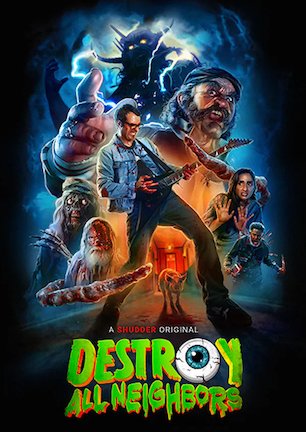Studio: Uncork’d Entertainment
Director: Brian Coyne
Writer: Brian Coyne
Producer: Brian Coyne, Shawn Coyne, Josh Russell, Sierra Russell, Brianna Jackson, Rich Marincic
Stars: Andy Ostroff, Heather Adair, Alyssa Koerner, Kyle Koerner, Jose Rosete, Noel Bruno, Lisagaye Tomlinson, Elizabeth Stahl, John Zion, Sara Winter, Chris Baer
Review Score:
Summary:
A young couple discovers that their autistic daughter may be possessed by a demonic power.
Review:
The medical diagnosis of eight-year-old Imogene might be autism, but with wild dogs barking throughout the night, closet doors opening on their own, and strange mist clouds forming indoors accompanied by the stench of sulfur, Nathan and Sophia can’t help wondering if something more spiritually sinister might be haunting their daughter. Doctor Ann thinks that using cameras to record Imogene’s increasingly worrisome behavior 24/7 will help the troubled couple solve the supernatural mystery. At the very least, what they record results in a head-on collision of the “found footage” and demonic child subgenres, leaving “Infernal” to beat two dead horror horses with one limp stick.
The script for “Infernal” is a circle, and the “found footage” format is a square. Writer/director Brian Coyne shoves his hardest to force the two together, but this is a clear case where the first-person card is played for reasons of economics, not because it slides smoothly into the story.
Rarely does the camera’s usage make contextual sense. The film opens with Nathan turning the camcorder on himself as he and Sophia prepare to move into a new home. At what point in the future was the couple planning to watch video of them packing boxes? Conveniently, Sophia chooses that moment to reveal she is pregnant and the camera captures Nathan taking a knee to spontaneously propose. Then the crucifix on the wall joins in the serendipity by spinning shakily upside down before the house (i.e. camera) quakes violently and the screen goes black without explanation.
Cut to Nathan and Sophia’s wedding, recorded with plenty of wobbly, occasionally blurry, and often zoomed in too far angles by Nathan’s best friend Stan. Guests give testimonials that should flesh out backstories of the primary protagonists, but instead become uninteresting asides about the tellers themselves, none of whom are seen again. Sophia’s college friend ponders which embarrassing anecdote to relay without ever telling one at all. Another woman complains about being single. One man has an argument with cameraman Stan over a beef in their personal history. Every single second of this sequence should be in the trash bin on the editing computer’s desktop.
Scenes in the psychiatrist’s office also play out in POV without justifying the camera’s presence or the footage’s actual purpose. Is the doctor recording patient sessions? If so, why is the back of her head filling half the frame while the couple only appears from their necks up in a lower corner? The window behind everyone takes up more of the picture than anything.
The rationale behind the constant recording at home is that the doctor thinks it will help monitor Sophia’s behavior, even though Nathan only reviews the footage one time (and never at all once a demonic monster starts creeping around his daughter’s bedroom at night). Except that doesn’t explain the footage recorded before she makes the suggestion, nor does it justify why one character confusingly chooses to film himself committing a crime while disposing of a dead body later in the film.
Sophia and her mother have a discussion about Imogene on an outdoor bench, with Sophia having presumably taken the time to place a camera behind them to record it. In a “found footage” film, it is a simple matter to avoid staging intimate scenes in a public park. Find locations where capturing an interpersonal conversation on camera makes some semblance of sense.
The construction of the film is not plotted with enough forethought and with seemingly little concern for disbelief suspension. A key creature is overlit to look like a cartoonish beast from a 30-year-old episode of “Tales from the Darkside.” An echoing demon voice sounds like a carnival funhouse muah-ha-ha filtered through a Wendy’s drive-thru microphone. And whether it is underscoring their wedding footage without being edited or featured in a weird dance montage eight years later, the family cannot stop listening to the same imitation power pop music provided by the film’s Special Effects Coordinator. Low budget movies cannot afford to license recognizable songs or artists, and such productions often double as vehicles to do favors for friends, but filmmakers should realize that they make these inclusions at the expense of realism.
“Infernal” can’t make up its mind on where to go or how to get there. Much of the movie is spent developing an average relationship drama consisting of Nathan and Sophia or Nathan and Stan having the same arguments repeatedly. Nathan flip-flops his position on Imogene’s affliction to stall the runtime. Time spent with others including a priest, a babysitter, and Sophia’s mother amount to trifling diversions ultimately bearing no significance on the plot’s outcome. When a sore thumb scene of daddy teaching daughter how to swing a hammer sticks out as existing strictly for foreshadowing purposes, a countdown begins to Imogene using said hammer on a living being and hopefully concluding the movie.
Inexplicably random cuts to cameras that should not exist. Camera setups that are either painfully obvious or woefully misplaced. A seen-before story developed at a snail’s pace in a format that doesn’t fit the fiction. As much as Imogene is possessed by an evil entity, “Infernal” is possessed by a plague of poor filmmaking choices, and cannot help but sink because of it.
Review Score: 35







“Bambi: The Reckoning” delivers a headache-inducing hangover that’ll have audiences asking, “why in the world did I willingly watch this?”